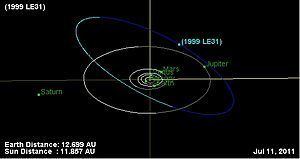Discovery date June 12, 1999 Observation arc 409 days (1.12 yr) Perihelion 4.3386 AU (649.05 Gm) Absolute magnitude 12.4 | Minor planet category damocloid Aphelion 11.939 AU (1.7860 Tm) Discovered 12 June 1999 Asteroid group Damocloid | |
 | ||
Discovered by Lincoln Laboratory Near-Earth Asteroid Research Team at Socorro Discoverer Lincoln Near-Earth Asteroid Research People also search for Solar System, 2000 DG8, 20461 Dioretsa | ||
1999 LE31 is a damocloid centaur discovered on June 12, 1999. It is both a Jupiter and Saturn-crossing minor planet.
1999 LE31 spends most of its orbit located in the outer Solar System between Jupiter and Uranus, and like all centaurs, has an unstable orbit caused by the gravitational influence of the giant planets. Due to this, it must have originated from elsewhere, most likely outside Neptune.
Of over half a million known minor planets, 1999 LE31 is one of about 60 that has a retrograde orbit.
1999 LE31 is approximately 16.8 km in diameter. It came to perihelion (closest approach to the Sun) in December 1998. It was last observed in 2000, and will next come to perihelion in February 2022.
Observations
This asteroid has been recorded at such observatories as:
